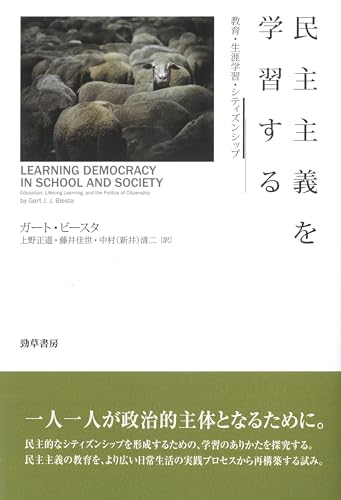1 0 0 0 OA 老健施設におけるリハビリテーションの現状と課題
- 著者
- 上野 正典 田中 みどり 今井 靖幸 渡邉 朝子
- 出版者
- 高山赤十字病院
- 雑誌
- 高山赤十字病院紀要 (ISSN:03877027)
- 巻号頁・発行日
- vol.38, pp.7-12, 2015-03-01 (Released:2015-08-12)
急性期・回復期のリハビリテーション(以下リハ)は、理学療法士、作業療法士、言語聴覚士の専門職が関わり、多い場合には1日に3時間ものリハを受ける機会がある。しかし退院後、生活期に移行すると、当施設をはじめ多くの老健施設では専門職によるマンツーマンで実施する個別リハの時間は大幅に減少する。そのため、入所される利用者の中にはリハに対し不安を抱かれる方も少なくない。武原は、急性期・回復期のリハが機能障害の回復を目的とした「治療モデル」であるのに対して、老健施設のリハは残された心身機能でいかに快適な生活を実現するかをテーマにした「生活支援モデル」であると位置づけている。そこで今回、病院リハを終了後に当施設へ入所された利用者の身体機能、精神機能、ADLを評価し、当施設のリハにおける現状と課題を検証した結果、精神機能・ADLにおいて有意差を認め改善傾向を示すことが示唆された。
1 0 0 0 犯罪捜査のための法医学
1 0 0 0 民主主義を学習する : 教育・生涯学習・シティズンシップ
- 著者
- ガート・ビースタ著 上野正道 藤井佳世 中村(新井)清二訳
- 出版者
- 勁草書房
- 巻号頁・発行日
- 2014
1 0 0 0 IR <報告>まず大人が変わらんと・・・日本のフィールド教育
- 著者
- 上野 正博
- 出版者
- 京都大学フィールド科学教育研究センター
- 雑誌
- 時計台対話集会
- 巻号頁・発行日
- vol.7, pp.51-58, 2011-02-28
第7回時計台対話集会「森里海をつなぐ人づくり」, 京都大学百周年時計台記念館百周年記念ホール, 2010/11/20
- 著者
- 上野 正章
- 出版者
- 日本サウンドスケープ協会
- 雑誌
- サウンドスケープ (ISSN:13454404)
- 巻号頁・発行日
- vol.7, pp.37-46, 2005-08
1 0 0 0 IR 1930年代のデューイにおけるコミュニティ・スクールの構想--活動的な学習実践の創造
- 著者
- 上野 正道
- 出版者
- 大東文化大学
- 雑誌
- 人文科学 (ISSN:18830250)
- 巻号頁・発行日
- no.13, pp.121-140, 2008-03
- 著者
- 上野 正道
- 出版者
- 関西大学
- 雑誌
- 教育科学セミナリー (ISSN:02880563)
- 巻号頁・発行日
- vol.37, pp.61-68, 2006-03-31
1 0 0 0 鼻腔領域に進展した球状上顎嚢胞の2例
- 著者
- 山本 悦秀 佐藤 建夫 岸村 真澄 清水 正嗣 上野 正
- 出版者
- The Stomatological society, Japan
- 雑誌
- 口腔病學會雜誌 (ISSN:18845185)
- 巻号頁・発行日
- vol.43, no.4, pp.549-554, 1976
- 被引用文献数
- 2
1 0 0 0 OA ティシューエンジニアリングチャンバーを用いた血管柄付き皮弁作製の実験的研究
Tissue engineering chamber(以下、TEC)を再生の場として、動脈血管束,人工真皮, FGF-2、多血小板血漿(PRP)を併用して、独自の栄養血管を有した軟組織を再生する方法を検討した。実験群は、コントロール群、非活性化PRP群、活性化PRP群、活性化PRP群+ FGF-2群、非活性化PRP+ FGF-2群の6群(n=5)に分け、再生組織の量、器質化の成熟度、血管新生について検討した。結果:血管付軟組織の再生組織量はcontrol群1. 13±0. 33cm^3、非活性化PRP群1. 79±0. 35cm^3、活性化PRP群1. 48±0. 22cm^3で、非活性化PRP群がcontrol群に比し有意差を認めた(p<0. 05)。人工真皮の器質化も非活性化PRP群で進んでいた。TECを用いた血管柄付き軟組織再生において、活性化PRPよりも非活性化PRPが有用であることが判明した。
1 0 0 0 IR 少年法の適用年齢について
- 著者
- 上野 正雄
- 出版者
- 明治大学法律研究所
- 雑誌
- 法律論叢 (ISSN:03895947)
- 巻号頁・発行日
- vol.82, no.1, pp.113-133, 2009-09
二〇〇七年五月一四日、「日本国憲法の改正手続に関する法律」(マスコミ略称「国民投票法」)が成立し、同月一八日公布された。この法律では、「日本国民で年齢十八年以上の者は、国民投票の投票権を有する。」(同法三条)とされているが、付則三条一項において「国は、この法律が施行されるまでの間、年齢満十八年以上満二十年未満の者が国政選挙に参加することができること等となるよう、選挙権を有する者の年齢を定める公職選挙法、成年年齢を定める民法(明治二十九年法律第八十九号)その他の法令の規定について検討を加え、必要な法制上の措置を講ずるものとする。」とされたうえ、同条二項において「前項の法制上の措置が講ぜられ、年齢満十八年以上二十年未満の者が国政選挙に参加すること等ができるまでの間、第三条…略…の規定の適用については、これらの規定中『満十八年以上』とあるのは『満二十年以上』とする。」こととされた。
1 0 0 0 IR デューイにおける美的経験の再構成--公共性の基礎としての芸術
- 著者
- 上野 正道
- 出版者
- 東京大学大学院教育学研究科
- 雑誌
- 東京大学大学院教育学研究科紀要 (ISSN:13421050)
- 巻号頁・発行日
- vol.42, pp.283-291, 2002
This paper clarifies John Dewey's reconstruction of the aesthetic experience in light of recent studies that interpret his theory of art as being related to social and cultural issues. By focusing on Art as Experience (1934) and his other works in the 1920s and the 1930s, the following three points are indicated. First, he developed his concept of art through his inquiry into the common experience shared by mankind. By criticizing art that is spiritualized out of any connection with the world of daily life, he insists that the experience of art is public and communicating since it has the potential to create community. Second, Dewey was critical of the nationalism and the expansion of the market mentality in the 19th century that had deprived art of the actual sense of community and helped to separate people's experiences. In contrast, his theory of art reflected the public participation of the mass culture in the 20th century. Third, it is of great help to see Dewey's friendship with Albert C. Barnes. Barnes established the school that idealized Dewey's concepts of democracy and art education, though they faced many difficulties of putting their ideals into practice. It follows from these that Dewey attempted to construct a publicness founded on the aesthetic experience of the community.
1 0 0 0 IR 罰金刑の合理化
- 著者
- 上野 正雄
- 出版者
- 明治大学法律研究所
- 雑誌
- 法律論叢 (ISSN:03895947)
- 巻号頁・発行日
- vol.81, no.4, pp.35-60, 2009-03
罰金刑は刑罰の王である。もちろん我が国における裁判中の数量的割合においてであるが、後記のとおりそれがほぼ九割に達している以上、こう言っても間違いはないであろう。とすれば、そのあり様は刑事政策的観点から見て非常に重要なものであると言わざるを得ないはずである。では、現実はどうか。近時の社会の関心は死刑や絶対的無期刑といったより重大な刑罰に専ら向いているようである。全国紙においてさえ、労役場留置される罰金刑受刑者が近時増えている事態を、こともあろうに「モラル崩壊顕著に」という見出しで報道しているような状態である。本稿では、このような罰金刑について、その制度の仕組みと現状を概観したうえで、問題点とその改善策を労役場留置と日数罰金制を中心に検討することによって、刑事政策的により有意義な罰金刑のあり様を模索したい。
1 0 0 0 OA オイゲン・ヘリゲルの禅理解 : 鈴木大拙の掌上で
- 著者
- 上野 正二
- 出版者
- 大分県立芸術文化短期大学
- 雑誌
- 大分県立芸術文化短期大学研究紀要 (ISSN:13466437)
- 巻号頁・発行日
- vol.45, pp.A1-A25, 2007
1 0 0 0 仔稚魚の日周活動リズムが魚群形成に果す役割に関する研究
魚類の遊泳行動に見られる日周活動リズムの持つ役割を、魚群形成過程の面から検討した。カタクチイワシは活動機能が低下すると浮上し、機能が活発になると沈降し深い層に移動する。この傾向は比較的初期の仔魚期からあらわれることを確かめた。さらにこの浮上・沈降の日周性と流れの鉛直シア-とを組み合せると種ごとに移動して行く方向に差が生じ、次第に魚種ごとの群となって行くことを確かめるため、海洋において実験を行なった。鉛直シア-、つまり表層から次第に深い層に行くにつれ流向が変る傾向は若狭湾西部において明確にあらわれていることを確かめた。特に表層と10mとで比較すると、表層では沖合へ、10m層ではそれと全く逆の湾奥方向へ流れていることを実測により見出した。また、この流れの測定と同時に表層と10m層のカタクチイワシ仔魚の分布密度を比較したところ、表層に分布する仔魚は流れの収束・発散の影響を受けて、集中分布をする傾向が強いことがわかった。仔魚は微細なため、長時間連続的に遊泳行動を記録するための特殊な自動記録装置を開発した。これは発光ダイオ-ドと光トランジスタを230個組合せて作られており、仔魚が発光部を通過すると、その位置・時刻が自動的にマイクロコンピュ-タの中に記録として取り込まれるようになっている。測器の開発及びプログラムに1年半を要したために、カタクチイワシの仔魚発生時期(6月から8月)の研究の間に合わなかったが、カワムツを用いた実験では日周活動リズムを記録することに成功した。これらのカタクチイワシによる日周活動リズムの解析と並行して、実際に海洋を回遊しているアカウミガメの日周活動リズムの解析にも成功し、この活動リズムが大規模な回遊をする際の定位と深いかかわりのあることを確かめた。この部分はすでに学会誌に報告した。


